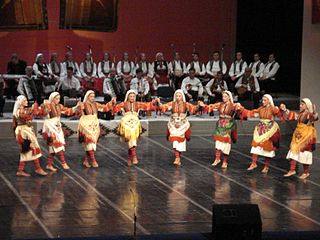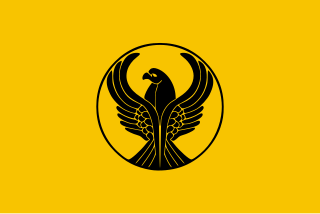
Hora, also known as horo and oro, is a type of circle dance originating in Aromanian and Romanian communities, especially in Romania and Moldova. It is also found in other South East European countries and culturally adopted by ethnic minorities such as the Ashkenazi Jews and the Roma.

Circle dance, or chain dance, is a style of social dance done in a circle, semicircle or a curved line to musical accompaniment, such as rhythm instruments and singing, and is a type of dance where anyone can join in without the need of partners. Unlike line dancing, circle dancers are in physical contact with each other; the connection is made by hand-to-hand, finger-to-finger or hands-on-shoulders, where they follow the leader around the dance floor. Ranging from gentle to energetic, the dance can be an uplifting group experience or part of a meditation.
Antikristos or Antikrystós is a dance of Greek origin. “Aντικρυστός” in Greek language refers to the verb αντικρύζω “be across, opposite, face-to-face”. It is also known in Armenia. Antikristos has similarities with the karsilamas dance. It is danced in couples.

Kochari is a folk dance originating in the Armenian Highlands. It is performed today by Armenians, while variants are performed by Assyrians, Azerbaijanis, Kurds, and Pontic Greeks. It is a form of circle dance.

The Pontic Greeks, also Pontian Greeks or simply Pontians, are an ethnically Greek group indigenous to the region of Pontus, in northeastern Anatolia. Many later migrated in various waves between the Ottoman conquest of the Empire of Trebizond in 1461 and the Russo-Turkish War of 1828–1829. Common migratory destinations included other parts of Eastern Anatolia, the former Russian province of Kars Oblast in the Transcaucasus, and the country of Georgia.
Koftos is a lively Greek dance typical of the areas of Thessaly, Epirus and central Greece. "Koftos" in Greek means to cut and the name of the dance comes from the periodic interruptions in the music/tune. When the music stops, the dancers yell "Hey", and you can also put your arms up, down, or clap. This sta dio (two-measure) style dance is a faster syrtos, that can also be danced going backwards and forwards or with partners.
Sousta is a Greek folk dance, performed at weddings as an activity of courtship between husband and wife. It originates from Ancient Greece, and holds prominence in Dodecanese Islands, and broader Aegean region. It is the second most common Greek dance, after the Syrtos, with many Greek islands and villages adopting their own version. The performance of the dance reflects various gender roles, inter-played with values of romance and marriage. The Sousta acted as a socialisation process between the youth of a village, evolving into a dance central to these youth as they grew up and formed relationships with others. Socially, the Sousta also functioned as a visible verification of courtship, namely paying respects to the wife and her family. The Sousta is most commonly performed as a three-step dance, with a 'hopping' motion and crossed-over hands.
Greek traditional music includes a variety of Greek styles played by ethnic Greeks in Greece, Cyprus, Australia, the United States and other parts of Europe. Apart from the common music found generally in Greece, each region of Greece contains a distinct type of folk music that originated from the region due to their history, traditions and cultural influences.

Turkish folk dances are the folk dances of Turkey. Facing three seas, straddling important trade routes, Turkey has a complex, sophisticated culture, reflected in the variety of its dances. The dominant dance forms are types of line dance. There are many different types of folk dances performed in various ways in Turkey. Zeybek, Teke Zortlatması in Aegean region, Bar in Erzurum province, Halay in the central, southern, eastern, and southeastern parts of the country, Hora in Thrace, Horon in the eastern Black Sea region, Spoon dances in and around Konya, and Lezginka in Kars and Ardahan are some of the best known examples of these.
Şiran is a town in Gümüşhane Province in the Black Sea region of Turkey. It is the seat of Şiran District. Its population is 11,539 (2022). It is one of the points of passage between Eastern Anatolia and Black Sea regions of Turkey, in the sense that the western road departing from Erzincan towards the Zigana Pass has its last urban stop in Şiran. The town lies at an elevation of 1,457 m (4,780 ft)
The Ballos is a Greek folk dance and a form of sirtos. There are also different versions in other Balkan countries.
Atsiapat, also spelt atsapat (Άτσαπατ), is the first in a sequence of three Pontic Greek male dances performed in the region of Pontus, as well as by refugees of Pontos. Atsapat is characterized by short steps and exaggerated movements that resemble stretching. This dance is followed directly by Serra. The final dance in the sequence is the Pyrrhichios.
Greek dance is a very old tradition, being referred to by authors such as Plato, Aristotle, Plutarch and Lucian. There are different styles and interpretations from all of the islands and surrounding mainland areas. Each region formed its own choreography and style to fit in with their own ways. For example, island dances have more of a different smooth flow to them, while Pontic dancing closer to the Black Sea, is very sharp. There are over 10,000 traditional dances that come from all regions of Greece. There are also pan-Hellenic dances, which have been adopted throughout the Greek world. These include specifically the Syrtos, Kalamatianos, Pyrrhichios, Ballos, Zeibekiko, and hasapiko.

Tamzara is a folk dance native to Armenian Highlands. In Armenia the dance originally had a ritual character, it was a wedding song and dance. Now "Tamzara" has lost its former ritual significance, when it was performed during almost all community events and parties. It is today performed by Armenians, Assyrians, Azerbaijanis, and Greeks. In post-Soviet Armenia, tamzara dance is gaining more and more popularity among all strata of the population.
Syrtos is – in classical and modern Greece – a traditional dance in which the dancers link hands to form a chain or circle, headed by a leader who intermittently breaks away to perform improvised steps.
The Dance of Osman Taka ; Greek: Οσμαντάκας or Σαμαντάκας) is a traditional dance in Albania and Greece. In Albania it is mainly danced by Cham Albanians. The dance bears the name of Osman Taka, a 19th-century Muslim Cham Albanian guerilla fighter who fought against Ottoman forces. It is a famous variation from the Albanian Cham repertoire of the older Çamçe dance.
Chilia kalos orisate, is a Greeks folkloric tune. The meter is 2
4.

Pontic Greek folk dances are a group of over ninety dances traditionally performed by Pontic Greeks. Dance has been an integral part of Pontian culture since ancient times. Dances vary based on region. Today, few Pontians remain in the Pontus region, but those living in the diaspora worldwide still perform folk dances to preserve their cultural heritage and group identity. Dances are accompanied by traditional music. Some traditional instruments include the lyra, daouli, zurna, dankiyo, tulum, and oud. The instrumental music may or may not be accompanied by singing.

Pontic Greek music includes both the folk music traditionally performed by Pontic Greeks and modern Pontic music. Song and dance have a long history in the Pontos, ranging from ancient dances to the Acritic songs to folk songs. Certain dances, accompanied by music, date to ancient times, such as the pyrrhichios. Pontic music evolved alongside Pontic dance.








